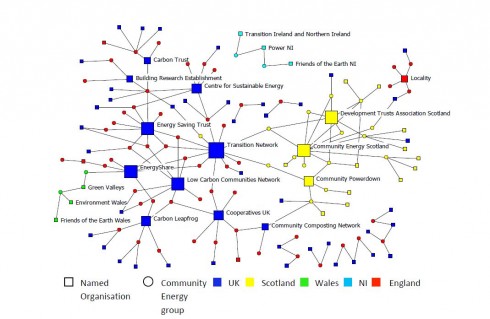"The other aspect of networking explored was the links these projects had with intermediary organisations and networks. This built up a fascinating picture of the web of organisations, from local networks to national networks, national-scale organisations, public sector and third sector organisations and private organisations. The authors mapped these relationships in what they call a ‘sociogram’ which shows the complexity of these relationships, and who influences who (see below, click to enlarge).
It concludes that “Transition Network was the most commonly named organisation” by respondents, and this is reflected in the sociogram. Given that it is followed in the list by organisations such as the Energy Savings Trust whose resources and size far outstrip Transition Network’s, this is a fascinating taste of the impact of Transition, and of how it works, being as much an idea, a unifying context and identity, a motivating concept and active network, as it is a provider of tangible support in relation to community energy. For an organisation that has been around for only a short time, and whose staff consist of less than 10 people, this is really something to celebrate I feel."
From a systems theory approach, I would call Transition Towns' collection of unifying contexts and ideas an attractor around which groups can self-organize. Multiple groups linked by these common ideas form a network to continue sharing, learning and building the network to a new emergent level of social organization, perhaps a regional ecology.

